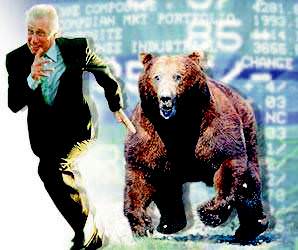How to Capitalize in a Bear Market
“The fact that the market is falling isn’t necessarily a bad thing. It’s how you play the game that matters!”
Contributed by Derreck Fung, Arbitrage Affiliate Blogger
www.fungmoney.com
A bear market is defined as a prolonged period of falling stock prices and pessimism, usually caused by high unemployment or high inflation. Bear markets usually take place during a Recession – defined as two consecutive quarters of negative GDP growth. Many people lose money during a bear market. However, there also exist people who are making money by betting in the fall of the market. There are a couple of ways to do this:
1) Short Selling: An investor who short sells a stock is betting that the price will go down. The investor essentially sells a stock that they don’t own, with the promise of returning it later on, hopefully when the stock price is lower.
Here’s an example: Let’s say a short-seller is looking to borrow 100 shares of Company ABC stock currently selling at $60 per share. The seller borrows the 100 shares of Company ABC from their broker and immediately sells the shares on the market for $60 per share x 100 shares or $6,000.
Let’s assume that at a future point in time the price of Company ABC stock drops to $40 per share. The short-seller would then buy back the 100 shares of Company X at $40 per share or $4,000 and make $2,000 in profit.
[pullquote]Many people lose money during a bear market. However, there also exist people who are making money by betting in the fall of the market. [/pullquote]The theoretical limit of profitability in this example occurs if the price of Company X’s stock falls to $0 per share. At that point, the short seller purchases the stock of Company ABC for $0 and makes a profit of $6,000.
On the other hand, if the price of Company ABC’s stock were to rise to $1,000 per share, then the short seller would be forced to pay $1,000 per share x 100 shares or $100,000 and realize a loss of $94,000 on the transaction.
2) Buying an Inverse ETF: An Inverse Exchange Traded Fund (ETF) is is constructed by using derivatives for the purpose of profiting from a decline in the value of an underlying benchmark. Investing in these ETFs is similar to holding a short position. These investment vehicles are good for times when stock markets and indices are free falling – kind of like what we’re experiencing today.
These ETFs may allow you to bet that certain index is falling, a certain industry ProShares UltraShort S&P500 (NYSE:SDS). If you think that the TSX will be heading in a downward direction, you may purchase the Horizons BetaPro S&P/TSX 60 Bear (TSX:HXD).
If you think the U.S. Financial stocks are going to tank (if you invested in this in early 2007, you would probably be rich by now), you may purchase the ProShares UltraShort Financials (NYSE: SKF) ETF. As you can see, the fact that the market is falling isn’t necessarily a bad thing. It’s how you play the game that matters!
Arbitrage Magazine
Liked this post? Why not buy the ARB team a beer? Just click an ad or






























Share the post "How to Capitalize in a Bear Market"